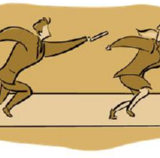Nearly every company revolves around the central idea of team performance. The synergy created by having multiple personalities and motivations can help any project be completed with efficiency and with quality results. Naturally, there are some times when things may not go as smoothly as planned. Indeed, if every effort always resulted in superior results, would there be any need for managerial oversight? More often than not, less-than-optimal performance may result from an individual’s lack of knowledge or desire rather than an entire team failing to deliver. So, what is the best approach to criticism feedback to the individual?
Many of us have seen instances where a group exhibited stellar performance on a specific task. More than likely, they were publicly praised; perhaps offered financial bonuses or other “spiff” that would serve as an incentive for others in the organization to perform similarly. However, how often do we see an unfortunate co-worker openly criticized for lack of performance? Quite frequently, any tirades will occur behind closed doors and away from the curious eyes and ears of other team members. Now, this is perfectly understandable, for a great deal of humiliation and anger may result if this act happened in public. So, management sees private criticism as saving a bit of dignity while simultaneously, any performance issues can be addressed one-on-one without any outside influences. Nonetheless, private criticism can actually have negative consequences on overall team performance. As this may come as a surprise to some, it is important to understand why this is the case.
A “Team” Lesson Learned?
One of the most important things to remember is that the accountability to the team can be called into question when an individual member is criticized alone by a manager. In fact, the entire point of team leadership and development is the interdependence fostered by interpersonal communication. If a member is suddenly removed and chastised, this group accountability can be undermined. Worst of all, the member may feel that he or she is responsible to management alone as opposed to fellow team members. This paradigm shift can have grave consequences, for it can lead to less cohesion within the team, it can germinate the “I versus we” mentality and should any problems arise in the future, individuals may be hesitant to bring them up to the team, and instead address management. All of these can have a decidedly negative result on overall intra-group performance.
Problem Solved, or Problems Created?
One of the reasons that management may choose to privately criticize is the belief that a problem can be more easily rectified by speaking to the employee that is held responsible. Surely enough, perhaps the two will in fact iron-out an agreement and both parties will leave the room satisfied. Has this strategy been presented to the other team members for opinions and feedback? Will the team even be informed that such an agreement has been reached? What we are presented with here is another fundamental flaw in the private criticism approach. The team may not be aware or able to adapt to any new guidelines that were agreed upon. What is worse is that as the individual in question has the approval of management and may be less likely to compromise within the team. Furthermore, let us not forget that the proverbial expression “passing the buck” is common in the business environment. The person being criticized may blame others for his or her mistakes. Thus, the management may have no choice but to spend even more time discerning fact from fiction while speaking to multiple other team members.
A Single Leader is Only Human
Leaders themselves suffer from flaws. Some may be rather timid when it comes to interpersonal discipline. Others may prefer a “hands-off” approach when it comes to criticism. Many display the ego (while necessary in many situations) that dictates their role as the ultimate mediator, decision maker and grand master of a team’s operations. These mentalities can further enhance the proclivity to deal with problems more “personally” and not involve the team. What results is the individual being criticized feeling an undue amount of pressure and the team may possibly feel alienated from the decision-making process. After all, it needs t be remembered that when a single link of a chain fails, the entire chain breaks.
While all of these observations may be easy to make, the next logical step is to examine what can be done to change this type of corrective approach. So, let us briefly touch upon a few key ways to constructively criticize within a team atmosphere.
Encourage the Team to Elect a Team Leader
Team leaders represent an excellent “middleman” between upper management and the employees themselves. By placing them in a role where they actively seek improvement, they will naturally become an integral part of the decision-making and therefore the criticism process. The benefit here lies in the fact that as they can address management with any concerns they may have, management can determine a solution, and then the entire team can be addressed regarding an individual’s shortcomings. This can help solidify cohesion and build team rapport.
Conduct Weekly Team Meetings
These meetings will not only serve as regular progress reports, but these times can also provide opportunities for any members (or management) to express grievances that may arise. This structure can greatly eliminate the need for private criticism and perhaps just as importantly, different team members can give insight into a particular problem. In fact, many companies are now employing this strategy as a means to increase communication while simultaneously identifying any problems before they become monumental hindrances.
Encourage Team Communication
There are those who say that by the time a problem has to be addressed behind closed doors, it has already become too large. There may be some truth in this statement, and an excellent method for preventing such undesirable circumstances is by encouraging teams to solve their problems within the confines of their own environment. They should only come to management when a problem cannot be properly addressed. Now, this is not to say that a manager should close his office door and play solitaire until someone comes knocking. This is rather another template that emphasizes both intra and inter-departmental accountability.
Not a single soul likes to receive criticism, and only a sadist enjoys giving it. Nonetheless, privately attempting to solve a problem either to save face or to avoid embarrassment can only lead to a further breakdown in communication and team performance over time. This few simple steps can help rectify an issue before it becomes a major problem and can likewise help make each member feel that they are contributing more to the overall performance of the company.
You may also want to check out Four Tips for Managers to Resolve Employee Conflict.











